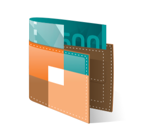Budgeting
If I budgeted I could've bought...
Do you find yourself in the same situation?
Know what you can afford
These five easy steps will get you started in drawing up a budget:

Distinguish between your needs and your wants.

List your sources of income.

List your expenses, including what you need to save.

Subtract your expenses from your income to see what you have left.

Keep track of your monthly expenses by updating your budget regularly.
Distinguish between your
needs & wants
- Each person's needs and wants are different. An accountant needs a laptop, but for many people, it would be something they want to have.
- Needs are things that you cannot do without. These generally include food, water, housing and basic clothing.
What is your monthly
income?
Income is any money you receive on a regular basis. You might earn income from various sources including: salary or wages, a social government grant, stipends, allowances (from family or friends) or child maintenance. Income also includes money from a business where you sell items, money received from renting out a room or running a guest house.
Types of expenses

Fixed expenses
The amount you pay does not change frequently and payments are made regularly (e.g. monthly) including rent or bond repayments, school fees, insurance premiums and car repayments.

Variable expenses
Expenses you pay every month but they change depending on your usage, for example: airtime/data, electricity, water, groceries, public transport or fuel for your vehicle.

Saving
Saving is essential and should always be listed on your budget as an expense. If you wait to see what is left at the end of the month, you will not save anything. Saving also ensures you are prepared for life's emergencies.
Tips to reach your
budget
- When you need to cut down on certain expenses, it is usually easier to cut down on variable expenses, especially variable wants.
- Budgeting isn't a once-off activity, you should revisit your budget regularly as your income or expenses change.


